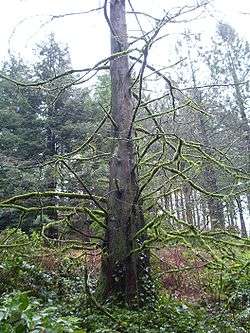Hoyt Arboretum
| Hoyt Arboretum | |
|---|---|
|
Weeping Sequoia (Sequoiadendron giganteum 'Pendulum') in Hoyt Arboretum | |
| Type | Arboretum |
| Location | Portland, Oregon, United States |
| Coordinates | 45°31′00″N 122°42′58″W / 45.51679°N 122.71600°WCoordinates: 45°31′00″N 122°42′58″W / 45.51679°N 122.71600°W |
| Area | 189-acre (76 ha) |
| Opened | 1922 |
| Status | Open to the public |
| Website | hoytarboretum.org |

The Hoyt Arboretum is located atop a ridge in the west hills of Portland, Oregon, United States. When the 160 acre (64.75 hectare) Multnomah County Poor Farm Hillside Farm west of Washington Park closed in 1922, the land was donated to the City of Portland to be used as a park, which later became Hoyt Arboretum.[1] The property has since increased in size through additional donations and acquisitoons to 189-acre (0.76 km2)(76 ha). The arboretum was founded by a coalition of timber industry representatives, the U.S. Forest Service, the Portland Parks & Recreation department, and enthusiasts.
The arboretum hosts approximately 6000 individual trees and shrubs of more than 2000 species from all over the world, 63 of which are vulnerable or endangered.[2] Most have labels identifying common and scientific names and region of origin.
The arboretum has twelve miles (19 km) of trails (two of which are suitable for wheelchairs), a visitor center, an indoor classroom with seating for 40 people, a picnic shelter and a meadow. Volunteer tour guides have been available since the 1970s.
The arboretum is located two miles (3 km) west of downtown Portland within Washington Park, and close to the Oregon Zoo, and the International Rose Test Garden. The Arboretum is open to the public and accessible at several points from Washington Park or from the Macleay Trail in Forest Park. The volunteer-staffed visitor's center is located at the center of the park and contains a small nature center and research library where visitors can find information about the park and its trees; the visitor's center is also the starting point for periodic volunteer-guided tours. [3]
Of note is the Dawn Redwood, one of only a few known deciduous conifers (needle and cone bearing trees that lose their leaves in the winter). The species was once thought extinct and known only in fossils, but was rediscovered in a remote valley in China in the early part of the twentieth century. The tree was reintroduced to the western hemisphere through saplings planted in the Hoyt Arboretum. The trees bear soft, short needles and have a distinctive look in that the branches seem to push out from folds in the trunk.
See also
References
- ↑ "History of the Arboretum Part I". Portland Parks and Recreation. Retrieved September 9, 2016.
- ↑ "Hoyt Arboretum Official site". Retrieved 2016-10-01.
- ↑ "Hoyt Arboretum Official site". Retrieved 2016-10-01.
External links
- Official Website
- The Tuesday Crew Documentary produced by Oregon Field Guide
